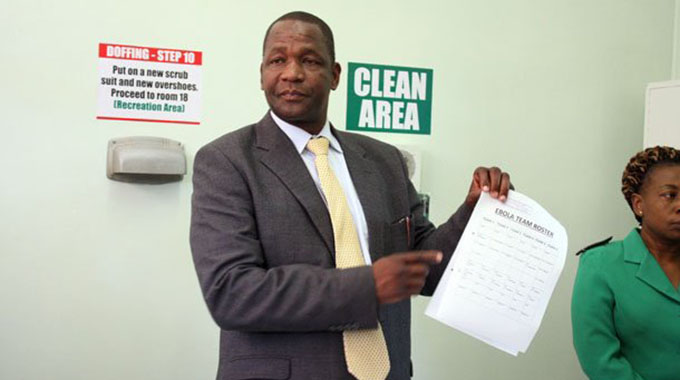Why we should care about disaster risk management

Beaven Dhliwayo Features Writer
In recent years, some types of extreme weather and climate mishaps have increased in frequency or magnitude, but populations and assets at risk have also increased, with consequences for disaster risk.
Disaster policy response to climate change is dependent on a number of factors, such as readiness to accept the reality of climate change, institutions and capacity, as well as willingness to embed climate change risk assessment and management in development strategies.
Some strategies for effectively managing risks and adapting to climate change involve adjustments to current activities. Present day climate change is attributed to increased levels of carbon dioxide, methane, nitrous oxides and other greenhouse gases in the atmosphere.
The World Meteorological Organisation (WMO) recommends a package of disaster risk reduction priorities to strengthen early warnings systems and cut socio-economic damages from weather, climate, and water-related hazards like tropical cyclones, floods and drought.
Adaptation to climate change and disaster risk management provide a range of complementary approaches for managing the risks of climate extremes and disasters.
Effectively applying and combining approaches may benefit from considering the broader challenge of sustainable development.
The Government should put in place measures that provide benefits under the current climate and a range of future climate change scenarios, called low-regrets measures as the starting point for addressing projected trends in exposure, vulnerability, and climate extremes.
The measures have the potential to offer benefits now and lay the foundation for addressing projected changes.
Many of these low-regrets strategies produce co-benefits, help address other development goals, such as improvements in livelihoods, human well-being and biodiversity conservation, and help minimise the scope for maladaptation.
Other low-regrets measures that Government should embrace include, but not limited to improvements to health surveillance, water supply, sanitation and irrigation and drainage systems; climate-proofing of infrastructure; development and enforcement of building codes and better education and awareness.
Effective risk management generally involves a portfolio of actions to reduce and transfer risk and to respond to events and disasters, as opposed to a singular focus on any one action or type of action. Such integrated approaches are more effective when they are informed by and customised to specific local circumstances.
Cyclone Idai, which the United Nations described as “one of the worst weather-related catastrophes in the history of Africa”, should be a wake-up call for Zimbabwe and other affected African countries about more high-impact tropical cyclones coastal flooding and intense rainfall linked to climate change.
Successful strategies the country should undertake include a combination of hard infrastructure-based responses and soft solutions such as individual and institutional capacity building and ecosystem-based responses. There is need for multi-hazard risk management approaches to provide opportunities to reduce complex and compound hazards.
Considering multiple types of hazards reduces the likelihood that risk reduction efforts targeting one type of hazard will increase exposure and vulnerability to other hazards, in the present and future.
Opportunities exist to create synergies in international finance for disaster risk management and adaptation to climate change, which the country have not yet realised. The world over, funding for disaster risk reduction remains relatively low as compared to the scale of spending on international humanitarian response and this has to be improved to save lives and infrastructure.
Technology transfer and cooperation are equally important to advance disaster risk reduction and climate change adaptation, according to a special report of Inter-Governmental Panel on Climate Change, dubbed, “Managing the risks of extreme events and disasters to advance climate change adaptation.”
“Coordination on technology transfer and cooperation between these two fields has been lacking, which has led to fragmented implementation.
“Stronger efforts at the international level do not necessarily lead to substantive and rapid results at the local level (high confidence). There is room for improved integration across scales from international to local.
“Integration of local knowledge with additional scientific and technical knowledge can improve disaster risk reduction and climate change adaptation (high agreement, robust evidence), says the report.
The Government also need to engage local populations to document their experiences with the changing climate, particularly extreme weather events, in many different ways, and this self-generated knowledge can uncover existing capacity within the community and important current shortcomings.
It is important because local participation supports community-based adaptation to benefit management of disaster risk and climate extremes.
However, improvements in the availability of human and financial capital and of disaster risk and climate information customised for local stakeholders can enhance community-based adaptation.
Under the international climate finance mechanism set up under the United Nations Framework Convention on Climate Change (UNFCCC), financial resources of up to US$100 billion per year will be availed through the Green Climate Fund and other entities.
The country has so far submitted project proposals to build community resilience and there is need for follow ups to ensure that the country fully benefit from that noble initiative.
Proposals include Building Resilience of vulnerable Agricultural Livelihoods in Mzingwane, Runde and Save River Basins (US$40 million), integrated Climate Risk Management for Food Security and Livelihoods in Zimbabwe ((US$10 million) and Catalysing Investment in Cleantech Innovation and Entrepreneurship for Green Jobs.
To contain the negative impacts of climate change each country is required by the Paris Agreement to take measures in limiting its greenhouse emissions.
Determination should also be shifted towards achieving the goals the country set in its Nationally Determined Contributions to the United Nations Framework Convention on Climate Change (UNFCCC), in 2015 where it committed to reducing greenhouse gas emissions by 33 percent per capita by the year 2030.
Key projects to achieve this include increasing hydroelectric generation, energy efficiency measure and electrifying rail. Appropriate and timely risk communication is critical for effective adaptation and disaster risk management.
Effective risk communication builds on exchanging, sharing, and integrating knowledge about climate-related risks among all stakeholder groups.
The country should adopt an iterative process of monitoring, research, evaluation, learning, and innovation which when implemented will reduce disaster risk and promote adaptive management in the context of climate extremes.
Moreover, addressing knowledge gaps through enhanced observation and research can reduce uncertainty and help in designing effective adaptation and risk management strategies.
However, the country need to improve on it human resources in offices dealing with climate change management.
The Climate Change Management Department currently operating with only six officers and the current structure is not in tandem with the devolution thrust of Government.
This has contributed to low levels of awareness by local government and communities. Government should act decisively and use all the opportunities in climate financing to avoid the damages caused by Cyclone Idai recently.









Comments